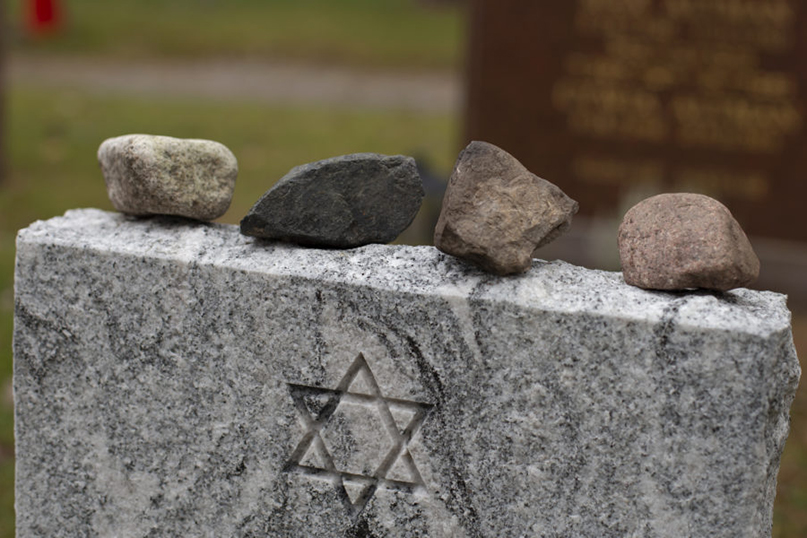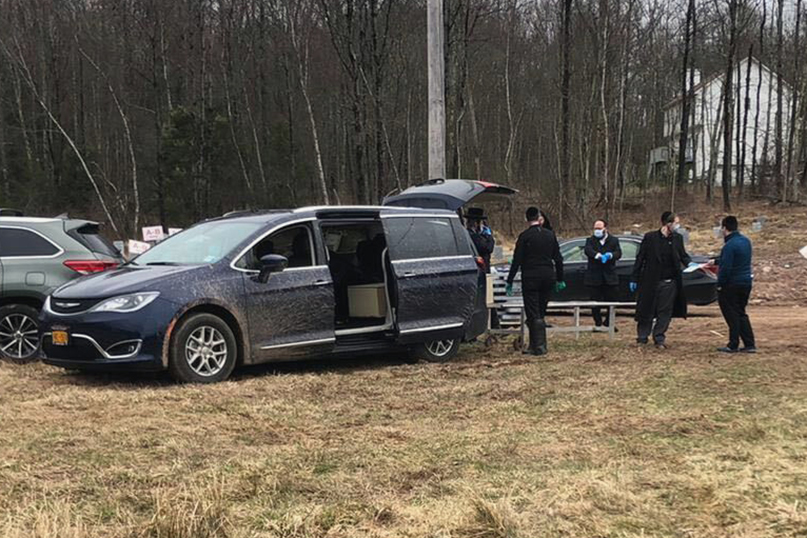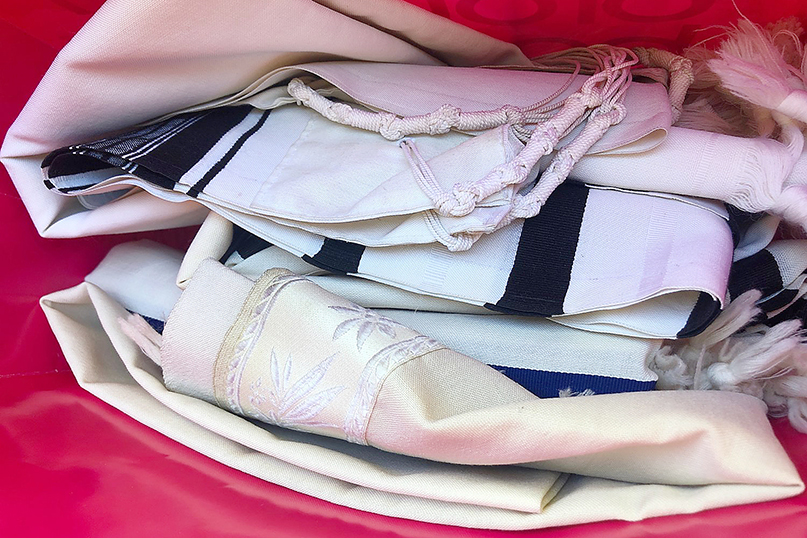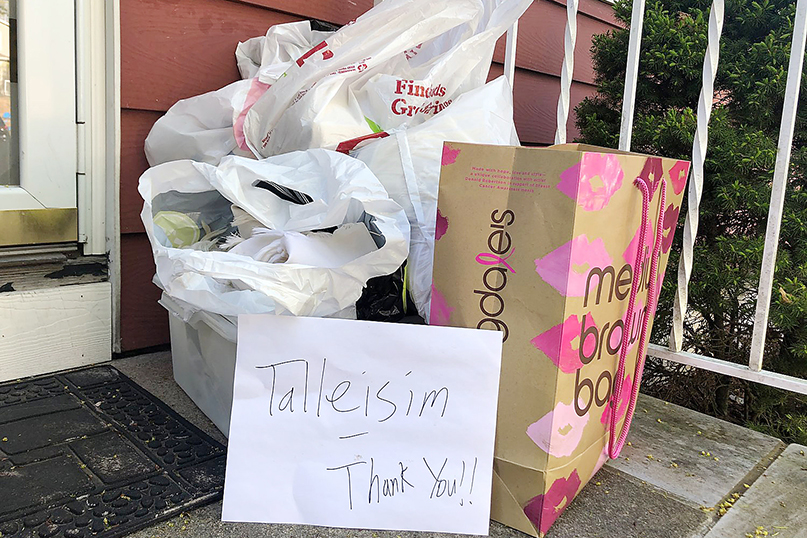
By Stacey Dresner
STATEWIDE – As he handles several COVID-19-related funerals over the past month, Leonard Holtz, director of Hebrew Funeral Association in West Hartford can’t help but recall Sept. 11, 2001, when he was a responder after the World Trade Center fell in New York City.
Dressed in protective gear – coveralls, mask, gloves, face shield, paper booties — Holtz went immediately to Ground Zero to honor the remains of Jewish victims who died in that devastating tragedy.
“Now 19 years later in 2020, I’m dealing with a threat called COVID-19…and wearing all of the protective equipment that I had utilized in New York for 9/11,” he told the Ledger. “There I could see the disaster. I could see Ground Zero in front of me; I knew what I was facing. But here, the threat to life is all over, and you can’t see it. …I’m going from one COVID-19 death to another; sometimes more than one COVID-19 death in a day.”
These days, when Holtz enters a hospital or nursing home to collect someone who has died, he has to have his temperature taken.
“If your temp is over 99 you’re not allowed into the facility, and that’s just to get to the morgue,” he says. “Some offices are closed. Some require that you slide under the door a folder to file a death certificate. Some require mailing in a death certificate, whereas it used to be walk-in, walk-out with a death certificate permit.
“Before I even enter the funeral home, before I even go into the garage, I am in gloves and a mask. Every surface that is used, stretcher, refrigeration unit, the car – everything that could possibly be contaminated is being sprayed, wiped, cleaned. The level of threat is constant, it changes with each case. With each funeral we are dealing with a need to sanitize. So everything about our environment has changed.”
Holtz and other local Jewish funeral directors are not only dealing with an increase in casualties during the coronavirus pandemic, they are now being forced to alter the way they hold Jewish funerals.

“Funerals are all private and graveside now,” says Michael Weinstein of Weinstein Mortuary in West Hartford. “Families are doing FaceTime funerals and Zooming funerals, as the only people that are allowed to be there are the immediate family.”
“At the funerals today we are social distancing,” Holtz said. “We are using cones to create a perimeter. Everyone must wear masks and gloves, including the rabbi.”
Busy with the prodigious number of COVID-related funerals in Fairfield County, the directors of Abraham L. Greene and Son Funeral Home were not able to return phone calls at press time. According to their website, however, Greene’s is conforming to the latest directives from Governor Lamont, the Connecticut Department of Public Health, and the Center for Disease Control…In addition, we continue to work with local clergy who are establishing their own protocols for officiating at and/or holding funerals within their synagogues and temples.”
The Connecticut Funeral Directors Association has sent its members guidelines for performing funerals as recommended by the Connecticut Department of Public Health and the Centers for Disease Control (CDC). At press time, the number of people attending funerals has been limited to five, which can be difficult for grieving families.
“The CDC says there should be no more than five people. The reality is that we’re saying no more than 10 people and ideally, we’d like to think we could have a minyan,” Holtz says.
“It’s pretty tough to limit it to five people if there are four kids and the spouses,” Weinstein adds.
Rabbi Daniel Cohen, spiritual leader of Congregation Agudath Sholom in Stamford, says that at this difficult time, pikuach nefesh – the Jewish law stating that the preservation of human life overrides virtually any other religious rule – must take precedence.
“We are literally in the midst of saving lives by not having people at the [funeral] service,” Cohen said. “I try to remind people of that – that distancing is what God wants at this point, as painful as it is.”
A double loss
On April 13, the Greater Hartford Rabbinical Association sent out guidelines for local funeral homes during the COVID crisis.
According to the Association, besides holding private graveside services and limiting the number of people at the cemeteries, those attending graveside services must be screened before they even get to the cemetery by the rabbi or funeral director who ask them a series of pointed questions about their current health and activities before allowing them to be present at graveside services.
Also as per the Association, those attending must wear masks and follow social distancing guidelines, and only a brief service should be held “including only the essential and necessary components (as per each denominational tradition).” The tradition of shoveling dirt is allowed, but gloves should be provided and after the shoveling, attendees should immediately leave the graveside so that cemetery staff can fill in the grave.
The Association recommends live-streaming services on social media platforms like Zoom for those who can not be there in person.
Eulogies and other components of a normal service should be done post-burial online, as should shiva gatherings.
“I think we have to recognize that the loss at this time is a double loss, because you are mourning the loss of life but you are also mourning the ability to mourn properly,” says Rabbi Tuvia Brander, president of the Rabbinical Association. “I think the rabbinate and rabbis across the world without fail are working to take care of pastoral needs and being creative and at the same time, not throwing our sacred and tried and true traditions out the window.”
The ultimate mitzvah
One such sacred tradition is tahara, the ritual purification of the deceased in which the body is cleansed with water and prayers.
“It’s called the ultimate in mitzvahs [known in Jewish law as a “chesed shel emet”] because it is a mitzvah that cannot be repaid,” says Jim Benjamin, president of the Stamford Chevra Kadisha [Jewish burial society]. “So you are doing something for someone and you don’t expect anything in return except to be respectful of the body and give them the proper send off.”
The tahara is performed by members of the local chevra kadisha coming together to perform the purification rite by gathering in a room at the funeral home and asking the deceased for forgiveness before pouring water over the body and reciting verses and prayers. They finish by dressing the body in white burial shrouds, placing it in the coffin and again asking for forgiveness for any mistakes they may have made during the tahara process.
The pandemic, however, has changed all that.
Some chevra kadishas across the country are performing tahara virtually. They meet over Zoom with a screen set up where the body lies. Using pitchers of water and empty bowls set up next to their home computers, they pour water from one vessel into another while reciting the verses and visualizing pouring the water over the body itself. Others are foregoing this the pouring of water over the body altogether. Still others are carrying on as before.
This in light of the CDC’s statement that, “There is currently no known risk associated with being in the same room at a funeral or visitation service with the body of someone who died of COVID-19”; but that, “People should consider not touching the body of someone who has died of COVID-19.”
In March, the Queens, New York National Association for Chevrah Kadisha (NASCK) and its leader Rabbi Elchonon Zohn put out a series of standards that chevra kadishas under their jurisdiction should follow the COVID crisis.
Benjamin called the NASCK standards for the tahara “very detailed, very difficult to comply with.”
“Some of our volunteers are in the medical field, but we felt it would be too long, too difficult to comply with and we would need a medical professional to be in there if we were to follow Rabbi Zohn’s March guidelines,” Benjamin says.
Instead, the Stamford chevra kadisha conferred with local rabbis and other chevra kadishas to learn how they were handling tahara.
“We wanted to see what they were doing to make accommodations to handle the tahara in a way that is what we call “kovod chodesh ha mais” – showing the utmost respect for the decedent,” says Benjamin.
Ultimately, says Benjamin, the board of directors of Stamford chevra kadisha voted to provide a limited tahara at the present time, operating under the standards now used by the White Plains, New York chevra kadisha.
“What they were doing was something that we felt we could implement, and we modified it to what we thought would be best for us in Stamford,” Benjamin says. “It took into account the safety of the volunteer…We talked to Rabbi Cohen about it, we talked to other rabbis about it. They said that’s fine. A member, Michael Feldstein, talked to Rabbi Zohn in Queens, and he said the procedure we wanted to implement was acceptable at this time.”
The limited tahara minimizes the number of chevra kadisha members per decedent and the amount of time spent. The modified procedure includes placing the garments and tallis on the deceased and the placement of soil from Israel inside the pine wood coffin. While one performs these duties, the other says the psalms and prayers. They are foregoing the cleansing of the body with water,
“Then we take the top which is secured by wood dowels and we make a prayer for the decedent saying, ‘I’m very sorry about your passing, please accept my apology for the things that I did not do knowingly or didn’t do unknowingly,” Benjamin explains.
In the Hartford area, the Orthodox chevra kadisha is following Rabbi Zohn and NASCK’s guidelines.
“We’re following those guidelines, continuing to do regular tahara, modified,” says Rabbi Brander. “I know there are other chevras who have ceased to do tahara. I think its really important that people recognize that we have to act in accordance with Jewish law, which takes into account very seriously the position and the direction of the medical community. Tahara is the last respect that we can pay to a person when they pass away, and it’s a last mitzvah.
“I can envision a time when, because there are these medical concerns and directions of doctors and the local department of health, that we might be not able to do formal taharas. In that case, what I have told families is that ultimately [the deceased’s] final mitzvah is keeping the living alive and that is an incredible mitzvah and one of the most important ones.
“Right now we still are doing taharas with careful protections and in accordance with state regulations. If there comes a point when we can’t, it is paramount for people to understand that tahara is a way for us to pay our last respects, and we are substituting that last mitzvah with another mitzvah — protecting the living.”
Leonard Holtz, who in addition his role as a funeral director has also performed tahara for many years, said that a huge concern of his is the wellbeing of the chevra kadisha.
“While gloves and gowns are always used, I began realizing quickly that that was not enough protection, especially since many, if not most of the people doing Tahara are 60 and over and have health-related issues as well,” he notes.
Holtz said the during this health crisis, while performing “respectful and spiritual preparation” shrouds, known as “tahrachim,” are being placed in many cases, over the pouch that the bodies are kept in, to protect the chevra kadisha volunteers and the funeral home staff. Some prayers are being said in Zoom sessions where the name of the deceased is invoked and the chevra seeks forgiveness for what may be a departure from what is normally practiced.
“There’s a recognition that nurses and doctors who know what they are doing are still getting infected — even those who are young and healthy, who exercise the precautions, who have much more equipment, have still been exposed,” Holtz says.
“For me now, I want to protect those wonderful men and women who are in the chevra kadisha. I refer to what they do as kovod ha’chai, kovod ha’mait — honor the living and honor the dead. …We need to understand that we live in an environment that is now threatening us… The safety of the people, I believe, is first and foremost. We hope to return to what we can do traditionally…But I’m willing to do what is necessary for the foreseeable future in terms of the level of protection that is needed.”
A Jewish burial association seeks prayer shawls for burials, and donations pour in
By hira Hanau
(JTA) – Andrew Parver’s phone hasn’t stopped ringing since a week ago Sunday.
That’s when Parver, the director of operations at the Hebrew Free Burial Association in New York City, put out a call for donations of prayer shawls for traditional Jewish burials. Less than 48 hours later, he had collected 150 himself and pledges of hundreds more to come from as far away as South Florida and Pittsburgh.
“My phone yesterday was nonstop – phone calls, emails, WhatsApps,” Parver told JTA on Tuesday, April 26. “I know rabbis have been sending this out to their congregations and I don’t even know the rabbis.”

The Hebrew Free Burial Association performs free Jewish burials for any Jew who dies without the funds for funeral expenses. Usually it has enough prayer shawls on hand to last for months. But the coronavirus pandemic has caused an unprecedented spike in demand for its services, and the group quickly ran out of shawls.
“We basically exhausted our supplies and our reserves,” Parver said. “We’ve never had anything like this.”
So on Sunday, Parver send out the word on an email list for the Jewish community in Teaneck, New Jersey. The next morning he posted an appeal on Facebook.
“Do you have any old Talleisim, regardless of condition, that you can donate to Hebrew Free Burial Association?” he wrote on the association’s Facebook page, using the Hebrew word for prayer shawls.
The donations started pouring in immediately.
By Sunday night, Parver had picked up about 100 shawls from homes in his area and found another 50 left on the doorstep of his home. Another 10 people volunteered their homes in New York, New Jersey and Baltimore as drop-off points for donations, thus far collecting at least 200 prayer shawls. With over 350 shawls collected already, Parver isn’t quite sure how many more to expect. But with calls from across the country continuing to come in, he’s sure there are more on the way. He’s also sure the need will continue to grow.

Traditional Jewish burial customs dictate that men are dressed in white shrouds and wrapped in a shawl before they are interred in a Jewish cemetery. The association does not dress women in prayer shawls, in line with Orthodox custom.
“For thousands of years, Jews have been buried the same way – plain shrouds, plain pine box,” Parver said, adding that it’s a way of “connecting to our ancestors.”
The association typically receives donations of shawls at a steady pace year round. They come from synagogues that close down or people who buy new ones after an older shawl wears out. Sometimes they come from people who find old shawls that belonged to parents or grandparents.
“Each tallis tells a story,” Parver said. “Somebody wore that tallis in shul, somebody shed tears while wearing that tallis, praying for something that was important at that stage of life.”
Some of the calls he’s received have hinted at the emotional connection people feel to their shawls. One rabbi told Parver that he had held on to an old shawl for years because of its sentimental value, but was prepared to let it go after hearing about the need.
Parver sees the outpouring of donations as another way people are helping where they can at a time when leaving the house is a dangerous proposition.
“This is just a very tangible method for people to connect and give back more good into the world when we need it,” he said.
Main Photo Credit: Getty Images









 Southern New England Jewish Ledger
Southern New England Jewish Ledger












